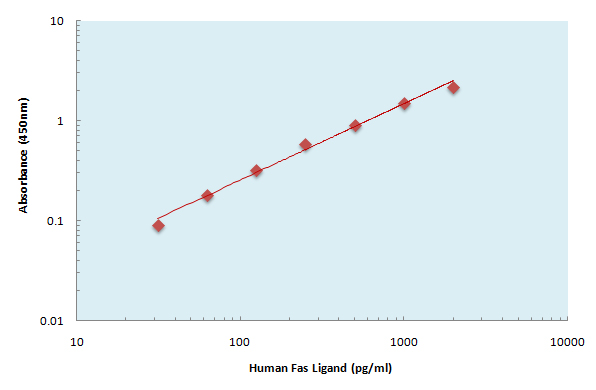Human Fas Ligand ELISA Kit
- Catalog No.:KE1119
- Applications:ELISA
- Reactivity:Human
- Gene Name:
- FASLG
- Protein Name:
- Tumor necrosis factor ligand superfamily member 6
- Human Gene Id:
- 356
- Human Swiss Prot No:
- P48023
- Mouse Swiss Prot No:
- P41047
- Specificity:
- Sample Type for Cell Culture Supernates, Cell lysates, Tissue Lysates, Serum, EDTA Plasma, Heparin Plasma
- Storage Stability:
- 2-8°C/6 months
- Other Name:
- FASLG;APT1LG1;CD95L;FASL;TNFSF6;Tumor necrosis factor ligand superfamily member 6;Apoptosis antigen ligand;APTL;CD95 ligand;CD95-L;Fas antigen ligand;Fas ligand;FasL;CD antigen CD178
- Detection Method:
- Colorimetric
- Background:
- disease:Defects in FASLG are the cause of autoimmune lymphoproliferative syndrome type 1B (ALPS1B) [MIM:601859]; also known as Canale-Smith syndrome (CSS). ALPS is a childhood syndrome involving hemolytic anemia and thrombocytopenia with massive lymphadenopathy and splenomegaly.,function:Cytokine that binds to TNFRSF6/FAS, a receptor that transduces the apoptotic signal into cells. May be involved in cytotoxic T-cell mediated apoptosis and in T-cell development. TNFRSF6/FAS-mediated apoptosis may have a role in the induction of peripheral tolerance, in the antigen-stimulated suicide of mature T-cells, or both. Binding to the decoy receptor TNFRSF6B/DcR3 modulates its effects.,online information:FAS-ligand entry,online information:FASLG mutation db,PTM:N-glycosylated.,PTM:The soluble form derives from the membrane form by proteolytic processing.,similarity:Belongs to the tumor necrosis factor family.,subcellular location:May be released into the extracellular fluid, probably by cleavage form the cell surface.,subunit:Homotrimer.,
- Function:
- eye development, response to molecule of bacterial origin, apoptosis, induction of apoptosis, inflammatory cell apoptosis, immune response, cell-cell signaling, sensory organ development, cell death, induction of apoptosis by extracellular signals, activation of pro-apoptotic gene products, response to bacterium, positive regulation of signal transduction, response to organic substance, developmental programmed cell death, regulation of protein kinase cascade, positive regulation of cell communication, positive regulation of protein kinase cascade, regulation of necrotic cell death, positive regulation of necrotic cell death, regulation of cell death, positive regulation of cell death,programmed cell death, induction of programmed cell death, death, response to lipopolysaccharide, regulation of apoptosis, positive regulation of apoptosis, regulation of programmed cell death, positive reg
- Subcellular Location:
- Cell membrane ; Single-pass type II membrane protein . Cytoplasmic vesicle lumen . Lysosome lumen . Is internalized into multivesicular bodies of secretory lysosomes after phosphorylation by FGR and monoubiquitination (PubMed:17164290). Colocalizes with the SPPL2A protease at the cell membrane (PubMed:17557115). .; [Tumor necrosis factor ligand superfamily member 6, soluble form]: Secreted . May be released into the extracellular fluid by cleavage from the cell surface. .; [FasL intracellular domain]: Nucleus . The FasL ICD cytoplasmic form is translocated into the nucleus. .
- June 19-2018
- WESTERN IMMUNOBLOTTING PROTOCOL
- June 19-2018
- IMMUNOHISTOCHEMISTRY-PARAFFIN PROTOCOL
- June 19-2018
- IMMUNOFLUORESCENCE PROTOCOL
- September 08-2020
- FLOW-CYTOMEYRT-PROTOCOL
- May 20-2022
- Cell-Based ELISA│解您多样本WB检测之困扰
- July 13-2018
- CELL-BASED-ELISA-PROTOCOL-FOR-ACETYL-PROTEIN
- July 13-2018
- CELL-BASED-ELISA-PROTOCOL-FOR-PHOSPHO-PROTEIN
- July 13-2018
- Antibody-FAQs
- Products Images

- The Human Fas Ligand ELISA Kit allows for the detection and quantification of endogenous levels of natural and/or recombinant Human Fas Ligand proteins within the range of 32-2000 pg/ml.



